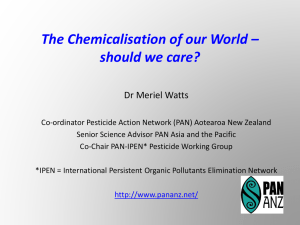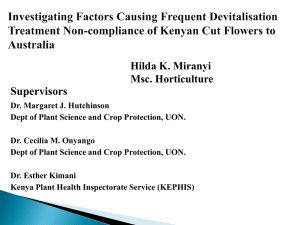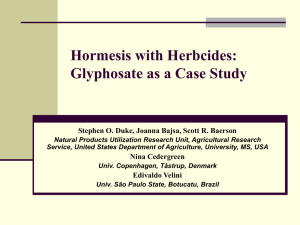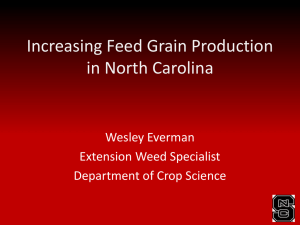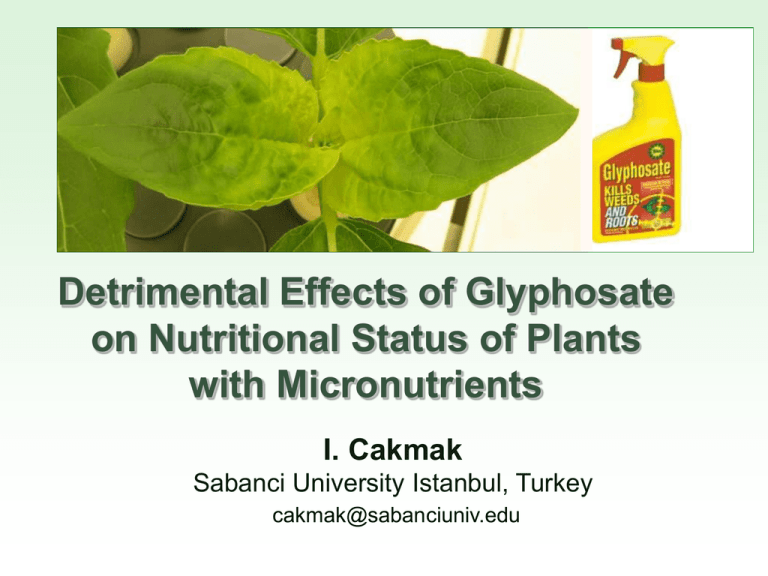
Detrimental Effects of Glyphosate
on Nutritional Status of Plants
with Micronutrients
I. Cakmak
Sabanci University Istanbul, Turkey
cakmak@sabanciuniv.edu
Glyphosate: extensively
applied herbicide
• Increasing usage in minimumand no-tillage agricultural
practices
• Extensive application on RR
crops
.
In regions with extensive
use of glyphosate there
are increasing reports on:
• reductions in growth and yield,
• increases in disease problems,
• increased use of insecticides and fungicides,
• inhibition of N fixing bacteria
• increased use of foliar micronutrient fertilizers
• micronutrient deficiencies
Particular micronutrient deficiencies induced by
Glyphosate: Manganese and Iron Deficiencies
Repeated use of glyphosate induces Fe
and Mn deficiencies in soybeans in USA
(Photo: Prof. Don Huber)
(areas which are not treated with glyphosate)
Glyphosate-induced Fe-deficiency chlorosis
+ gyphosate
+
seed Fe treatment
+ gyphosate
–
seed Fe treatment
- gyphosate
+
seed Fe treatment
Photo: N.C. Hansen,
Fort Collins, USA
(Jolley et al., Soil Sci Plant Nutr. 50, 793-981, 2004)
Interaction of seed applied Fe and
glyphosate application on Fe deficiency
chlorosis in soybeans; Minnesota, USA
visual chlorosis scrore
Treatment
(1=green to 5 =severe)
– Fe
Control
grain yield
+ Fe*
(t/ha)
– Fe
3.1
2.8
1.01
3.7
3.3
0.27
+ Fe*
1.70
(no herbicide)
Glyphosate
0.61
* 50g Fe/ha as FeEDDHA applied to seeds
(Jolley et al., Soil Sci Plant Nutr. 50, 793-981, 2004)
Foliar and Soluble Micronutrient* Sales in USA
RoundUp Ready
Corn, Soy
5000
4500
4000
3500
3000
2000
2001
2002
2003
2004
2500
2000
1500
1000
(*represents
500
approx 30%
of US Sales)
0
B
Cu
Fe
Mn
Zn
(Courtesy of Prof. P. Brown, UC Davis)
Glyphosate is toxic to plants whether from a drift
or residues in soil
A significant amount of glyphosate applied to target plants
reaches the soil as a result of direct contact, wash off from leaves
and exudation from roots of the treated weeds.
Up to 10 % of the applied glyphosate move to non-target plants
entweb.clemson.edu.
http://www.uky.edu/Ag/Tobacco/Pages/RoundupFloat.html
no
Glyphosate
with
Glyphosate
REMEMBER
Glyphosate is highly phloem mobile
Application of glyphosate on target plants
(weeds)/glyphosate resistant cultivars;
very quick uptake by leaves.
Rapid translocation of glyphosate
from shoot to root
Release of glyphosate into the
rhizosphere
Adaptive Root Responses of
Strategy-I Plants to Fe Deficiency
Rhizosphere/Soil
FeIII
Chelator
Apoplasm
Plasma
Membrane
TR
FeIII Chelate
FeIII
Cytoplasm
FeII
R
FeIII
H+
FeIII
PUMP
H+
Reductants
(Chelators)
Marschner and Römheld, 1995; Plant and Soil
R: Ferric Reductase
R
Effect of iron deficiency in cucumber on pH decreasing
and reducing capacity of the roots
+Fe
-Fe
+Fe
-Fe
Romheld et al., 1981
Effect of Glyphosate on Ferric Reductase
Time dependent inhibition of ferric reductase activity
Fe reduction capacity
-1
-1
(µmol Fe(II) g root dry wt 3 h )
in Fe-deficient sunflower plants (+Glyp: 1.89 mM glyphosate
or 6% of the recommended rate for weed control)
80
Fe deficient
LSD0.05
60
40
Control (+Fe)
20
0
-Glyp.
Ozturk et al., 2007
+Glyp.
6h
+Glyp.
12h
+Glyp.
24h
-Glyp.
+Fe
Fe reduction capacity
-1
-1
(µmol Fe(II) g root dry wt 3 h )
Dose dependent inhibition of ferric reductase activity
by glyphosate (+Glyp: 0.32, 0.95 and 1.89 mM
Fe deficient
80
60
LSD0.05
40
Control (+Fe)
20
0
-Glyp.
Ozturk et al., 2007
+Glyp. +Glyp. +Glyp.
0.32 mM 0.95 mM 1.89 mM
-Glyp.
+Fe
Foliar applications of glyphosate (Glyp) at 0.32 mM,
0.95 mM and 1.89 mM for 24h.
Staining of Ferric Reductase Activity
GLYPHOSATE
Ozturk et al., 2007
Fe Deficient Plants
Effect of foliar applied of glyphosate (1.89 mM ) for 24h
on ferric reductase activity.
-Fe
-Fe +Glyp (1.89 mM)
Ozturk et al., 2007
-G
lyp
.
+F
e
12
+G
ly
p . -G l
+G 0 yp
ly .32 .
p.
m
+G 0
M
.
9
ly
p. 5 m
1. M
89
m
M
(µmol g -1 FW)
Shikimate accumulation
Dose Dependent Shikimate Accumulation
15
Shoot
9
6
3
0
Ozturk et al., 2007
lyp
-G
l
+G . 0. yp.
lyp 32
m
.
M
+G 0.
9
lyp 5
. 1 mM
.8
9
m
M
-G
ly
p.
+F
e
+G
(µmol g -1 FW)
Shikimate accumulation
Dose Dependent Shikimate Accumulation
8
6
Root
4
2
0
Ozturk et al., 2007
15
Shoot
0
-G
+G l yp
lyp .
+G . 6
lyp h
+G . 12
lyp h
.2
4h
-G
ly
p.
+F
e
-G
ly
p.
+F
e
12
-G
+G l yp
lyp .
+G . 6
lyp h
+G . 12
lyp h
.2
4h
(µmol g -1 FW)
Shikimate accumulation
Time Dependent Shikimate Accumulation
8
Root
6
9
4
6
2
3
0
Ozturk et al., 2007
Short-Term Experiments:
Glyphosate inhibits root uptake and
root-to-shoot transport of micronutrients
ROOT UPTAKE
TRANSLOCATION TO SHOOT
Root Uptake
59
800
Fe
LSD0.05=108
600
Translocation
59Fe
25
59
20
LSD0.05=7.0
Fe
15
400
-1
Root uptake rate (nmol g root dry wt 4 h )
0
54
Mn
1200
LSD0.05=22.5
-1
900
54Mn
600
300
0
65
3000
Zn
LSD0.05= ns
2250
65Zn
Shoot translocation rate (nmol g-1 root dry wt 4 h-1)
10
200
5
0
LSD0.05=3.6
75
50
25
0
65
Zn
100
LSD0.05= ns
75
50
750
25
0
0
Glyphosate
Mn
100
1500
Control
54
125
Control
Effect of 1.89 mM
glyphosate (equivalent
to 6 % of the
recommended dosage
for weed control in the
field) on root uptake
and shoot translocation
of 59Fe, 54Mn and
65Zn in sunflower
plants.
Glyphosate
Eker et al., 2006: J. Agric. Food Chem. 26, 10019 -10025
Adaptive Root Responses to Iron
and Zinc Deficiencies in Cereals
Rhizosphere/Soil
Apoplasm
Plasma
Membrane
Cytoplasm
PHYTOSIDEROPHORES
FeIII
ZnII
FeIII
FeIII-PS
TR
ZnII
ZnII-PS
TR: Transporter Protein
Marschner and Römheld, 1995; Plant and Soil
FeIII-PS
ZnII-PS
Mugineic Acid Family
Biosynthetic Pathway of Mugineic Acid Family
Mori et al., 1990
Phytosiderophores
Fe
OH
Fe
NH2
Fe3+-Deoxymugineic acid
Fe3+-Nicotianamine
Similar Stereochemical Structure between
Fe3+-DMA and Fe3+-NA Mori, et al, 1990
Phytosiderophore
Release from Roots
Phytosiderophore release
-1
-1
(nmol PS plant 3h )
160
+Fe
-Fe, 0% Glyp
-Fe, 1% Glyp
-Fe, 3% Glyp
-Fe, 9% Glyp
120
80
40
0
+Fe
-Fe
Ozturk et al., 2008
Phytosiderophore Release from Wheat Roots
Phytosiderophore release
-1
-1
(nmol PS plant 3h )
160
120
80
+Fe
-Fe, 0% Glyp
-Fe, 1% Glyp
-Fe, 3% Glyp
-Fe, 9% Glyp
40
0
Ozturk et al., 2008
Glyphosate Applicaton
Mobilization of Zn from Calcareous Soil by Phytosiderophores
Control (+Fe, -Glyp)
-Fe, -Glyp
-Fe, 1% Glyp
-Fe, 3% Glyp
-Fe, 9% Glyp
0.3
-1
Mobilized Zn (µg g soil)
Mobilized Zn, µg -1 soil
0.4
0.2
0.1
0.0
Ozturk et al., 2008
Glyphosate Application
Mobilization of Mn from Calcareous Soil by Phytosiderophores
Mobilized Mn, µg -1 soil
Control (+Fe, -Glyp)
-Fe, -Glyp
-Fe, 1% Glyp
-Fe, 3% Glyp
-Fe, 9% Glyp
0.2
0.1
0.0
Ozturk et al., 2008
Glyphosate Application
REMEMBER
Glyphosate is highly phloem mobile
Application of glyphosate on target plants
(weeds)/glyphosate resistant cultivars;
very quick uptake by leaves.
Rapid translocation of glyphosate
from shoot to root
Release of glyphosate into the
rhizosphere
Glyphosate applied to target plants
is released into the rhizosphere
Induction of Fe deficiency chlorosis in non-target plants (sunflower)
Soybean
Target
Sunflower
Indicator
Soybean
Target
Sunflower
Indicator
Soybean
Target
Soybean
Target
(Neumann et al., 2005, J. Plant Dis. Prot.)
Glyphosate application to
target plants (soybean)
Development of Fe deficiency
symptoms in non-target plants …
Glyphosate released in the
rhizosphere reduces Mn uptake
54Mn
in shoots
Inhibited Mn acquisition
by non-target plants
(sunflower) grown in
nutrient solution together
with glyphosate treated
target plants (soybean)
for 2, 4 and 6 days.
Neumann et al., 2005, J. Plant Dis. Prot.
Significantly lower Mn uptake/accumulation
in RR-soybeans
leaf tissue Mn, ppm
120
KS 4202
100
KS 4202 RR
80
KS 4202
KS 4202R
60
40
20
0
2,5
5
7,5
Mn-rate, lb/a
(B.Gordon, 2006; Kansas State Univ.)
Inhibition of MnO2 Reduction in Soil-filled Rhizoboxes
after Glyphosate Treatment to Target Plants (soybean)
Control
+ Glyphosate
MnO2 Reduction in
Soil-filled Rhizobox
Culture of sunflower
(non-target)
and RR-Soybean with
and without foliar
Glyphosate spray
(Neumann et al., 2005)
Glyphosate Reduces Grain Mn, Mg and Ca
0
0.3
0.6
Glyphosate Application, %
0.9
Grain, straw and whole plant dry matter yield as
Dry matter yield, g plant-1
affected by drift rates of glyphosate in soybean
8.0
Grain
12
Straw
20
10
16
6.0
8
4.0
Whole plant
12
6
8
4
2.0
0.0
control 0.3
0.3
Control
0.6
0.6
0.9
0.9
2
4
0
0
control 0.3
0.3
Control
0.6
0.6
0.9
0.9
control 0.3
0.3
Control
0.6
0.6
0.9
0.9
Glyphosate treatment, % of recommended
Yazici et al., 2008
Glyphosate
Applied: 3 Times;
one before
flowering
and 2flowering
times after flowering
Glyphosate
applied
3 times
before
1.8
0.30
0.5
Mg
K
K
1.5
Ca
Mg
0.25
Ca
0.4
%
Grain concentration,
Grain concentration of K, Mg and Ca as affected
by drift rates of glyphosate in soybean
1.2
0.20
0.9
0.15
0.6
0.10
0.3
control
0
0.3
0.6
0.9
0.3 0.6 0.9
0.2
control
0
0.3 0.6
0.6 0.9
0.9
0.3
control
0
0.3
0.6
0.9
0.3 0.6 0.9
Glyphosate treatment, % of recommended
Glyphosate treatment, % of recommended
Yazici et al., 2008
Grain concentration,
mg kg-1
Grain concentration of Fe, Mn and Zn as
affected by drift rates of glyphosate in soybean
100
80
90
Fe
80
Fe
70
60
Mn
Mn
Zn
50
Zn
60
70
40
60
50
50
30
40
40
30
30
0 0.3
control
0.3
0.6
0.6 0.9
0.9
20
control
0.3
0 0.3
0.6 0.9
0.9
0.6
0 0.30.3
control
0.60.6 0.9
0.9
Glyphosate treatment, % of recommended
Yazici et al., 2008
Seed Mn and Ca very important
for seed viability and seedling vigour
Dry matter yield of young and old leaves of soybean
plants as affected by drift rates of glyphosate
Young leaves
Dry matter yield,
g plant-1
140
Old leaves
800
120
600
100
80
400
60
40
200
20
0
0
0
control
0.3
0.3
0.6
0.6
0.9
0.9
control
0
0.3
0.3
0.6
0.6
0.9
0.9
Glyphosate treatment, % of recommended
Yazici et al., 2008
Leaf concentration, %
Concentration of K, Mg and Ca in soybean
leaves as affected by drift rates of glyphosate
0.7
3.5
K
3.0
1.8
0.6
Mg
Ca
1.5
0.5
1.2
2.5
0.4
2.0
0.9
0.3
1.5
0.2
control
0
0.3
0.6
0.9
0.3
0.6
0.9
0.6
control
0
0.3
0.6
0.9
0.3
0.6
0.9
control
0
0.3
0.6
0.9
0.3
0.6
0.9
Glyphosate treatment, % of recommended
Hande et al., 2008
Plants with low Mg are highly
sensitive to glyphosate
Hande et al., 2008
Plants with low Mg are highly
sensitive to glyphosate
Hande et al., 2008
What is the effect of
Glyphosate??
Effectiveness of Glyphosate
Effect of Glyphosate with and without calcium in the tank
Control
Glyphosate
Glyphosate
+ Calcium
Glyphosate binds with the cations to form a
strong complex which is not bio-available.
Only unbound glyphosate act as a herbicide.
www.loveland.co.uk/ Gifs/X-Change-du-pont.gif
Glyphosate binds with the
cations to form a strong
complex which is not bioavailable.
Only unbound glyphosate act as
a herbicide.
Conclusions
• Routine glyphosate use in agricultural systems
results in considerable side effects on plant
growth and mineral nutrition of plants
• Glyphosate is antagonistic to the uptake,
transport and accumulation (tissue
concentration) of Fe,Mn, Ca and Mg possibly
due to the formation of poorly soluble
glyphosate-metal complexes (??)
Conclusions-cont
• Glyphosate impairs genetic adaptation
mechanisms of plants to Fe deficiency
• Plants grown under low Mg are very
sensitive to glyphosate
• A new risk assessment for glyphosate is
urgently needed,
Root Tips:
Co-localization of Ferric
Reductase and
Glyphosate Accumulation
Leading 10 Health Risk Factors in Developing
Countries, % Cause of Disease Burden
Underweight
14.9%
Unsafe sex
10.2%
Unsafe water
5.5%
Indoor smoke
3.7%
Zinc Deficiency 3.2%
WHO, 2002
Iron deficiency
3.1%
Vitamin A def.
Blood pressure
Tobacco
Cholesterol
3.0%
2.5%
2.0%
1.9%
Copenhagen Consensus-2004
Worldwide Panel of Distinguished Economists
including Nobel Prize-Winners
Top Four Global Challenges
• Control of HIV/AIDS
• Providing micronutrients (Fe, Zn..)
to human populations
• Trade Liberalization
• Control of Malaria
Source:: http://www.copenhagenconsensus.com)
Interference of
glyphosate with root
uptake and transport of
micronutrients may also
represent a potential
threat to human
nutrition and human
health
L. Ozturk
Sabanci University
G. Neumann
T. Tesfamariam
Fanghua Ye
C. Weishaar
K. Stock-de Oliveira Souza
E. Landsberg
S. Kohls
University Hohenheim (U.H.)
V. Römheld
(S. Bott: Uni.Hohenheim)
T. Yamada
I. Cakmak
Obrigado…
Sabanci University
Shoot and root dry matter production and chlorophyll level as
influenced from glyphosate application for 24 h
-Fe
-Glyp.
+Glyp. 0.32 mM
+Glyp. 0.95 mM
+Glyp. 1.89 mM
Dry matter production
Shoot
Root
(mg plant-1)
208 ± 16
58 ± 8
202 ± 16
55 ± 8
208 ± 15
56 ± 11
194 ± 23
53 ± 9
Chloropyll
(SPAD)
21.2 ± 1.0
21.3 ± 0.7
21.7 ± 1.4
21.8 ± 2.3
+Fe
-Glyp.
226 ± 30
39.2 ± 1.9
Treatments
LSD0.05
24
61 ± 13
12
Ozturk et al., 2007
2.3
+G
ly
+G
ly
+G
ly
1.
89
0.
95
0.
32
-G
lyp
p
p
p
+F
e
m
M
m
M
m
M
-G
lyp
Total carbohydrates
(mg glucose equiv. g-1 FW)
Carbohydrates in Apical Parts of Roots
15
+ Glyphosate
12
9
6
3
0
Ozturk et al., 2007
Root Responses to Fe
Deficiency in Strategy-I Plants
Rhizosphere
FeIII
Chelator
Apoplasm
Plasma
Membrane
TR
FeIII Chelate
FeIII
Cytoplasm
FeII
NAD(P)H
R
FeIII
NAD(P)+
H+
FeIII
PUMP
H+
Reductants
(Chelators)
Marschner and Römheld, 1995; Plant and Soil
R: Ferric Reductase
R
1.
89
0.
95
0.
32
-G
lyp
p
p
p
+F
e
m
M
m
M
m
M
40
+G
ly
+G
ly
+G
ly
-G
lyp
NADPH oxidation
(nmol min-1 g-1 FW)
Capacity of Roots to Oxidize NADPH
+ Glyphosate
30
20
10
0
Ozturk et al., 2007
Close Relationship between Fe Deficiency
Tolerance and Ferric Reductase Activity in Soybean
Soybean Genotypes
Marschner and Romheld, 1995
Release of chelating compounds
(µmol Fe equiv. g-1 fresh wt. h-1)
Release of Phytosiderophores from Roots Correlate with
Tolerance Fe Deficiency Chlorosis
60
50
+Fe
-Fe
40
30
20
10
0
rice
sorghum
maize
oat
Wheat
Chlorosis resistance
(Römheld & Marschner (1986): Adv. in Plant Nutr 2, 155-204)


